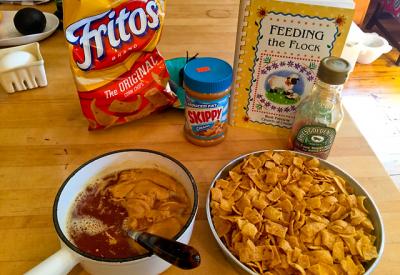Seasons by the Sea: A Chef’s Cabinet of Curiosities

If you are a writer, chances are your friends bestow upon you fascinating books, blank journals, and fancy pens as gifts. If you are an artist, you may receive canvases, paintbrushes, inks, and oils. If you are a gardener, perhaps you have received heirloom seeds, exotic orchids, and colorful books of English rose gardens. As a semi-retired pastry chef and food writer, my friends and family have given me endless pleasure and puzzlement with the most staggering array of cooking equipment, ancient cookbooks, and truly peculiar ingredients.
Have you ever heard of ebelskivers? Miraculin? Pandan extract? A Toas-tite? Go! Go! Curry sauce? The Smoking Gun? These are some of the fascinating items I have been given over the years, along with X-rated potholders (anatomically correct male and female), a first edition 1902 White House Cookbook, and a kitschy pie server shaped like a dressy shoe with a crystal heel. This last one always gets some giggles when I ceremoniously pull it out to slice into a homemade blueberry pie or quiche.
My dear childhood friend Dicky is also an avid cook. He is responsible for the ebelskiver and the Smoking Gun. We’ve spent a good amount of time fiddling with these contraptions when he visits. The ebelskiver is a Danish invention, a cast iron pan with deep round indentations to cook little pancake/popovers with fillings. They are mostly meant to be sweet, but we thought a savory version with a little cube of Gruyere cheese in the middle would make a pretty soigné canapé!
The Smoking Gun looks like a piece of medical equipment with a rubber tube and motorized hot fan. You add some wood chips (cherry, mesquite, apple), turn it on, and trap the smoke over some bourbon or beets or potatoes or whatever. I think my true chef and bartender friends play with theirs more than I play with mine.
Along the lines of “what the heck do I do with that?!” is the pandan extract. This comes from the Pandanus amaryllfolius plant, common in Southeast Asian cooking. The extract is used in sweet and savory cooking and has an aroma similar to basmati rice — nutty and botanical. The extract is a brilliant green and one of these days I plan to attempt a pandan chiffon cake. This was given to me by a chef friend Daniel.
When he gets a break in the summer, he goes to a remote island off of Brittany and harvests sea salt and wild fennel pollen. He brought me a jar of this pollen salt recently and I must say, it has become my favorite finishing salt of all time. Just sitting on the table, its fragrance wafts around in a heavenly way. I have used it before searing a filet mignon, in mashed potatoes, on green beans, and sprinkled on good butter to serve at the table.
Many years ago, before computers and Amazon, those gateways to getting any damn thing you want from around the world, my friend Cheryl brought me little packets of squid ink from Italy. I squealed with delight as onlookers wrinkled their noses in disgust. I had had squid ink pasta and risotto on my honeymoon and loved it and never thought I’d see it again. It is salty, briny, umami, and black as night. It was a risky gift, but so much appreciated.
My son gave me the miraculin, or “miracle fruit,” which is a glycoprotein that binds to your taste buds and makes sour fruit taste sweet. This was, for sure, a weird science novelty.
When it comes to cookbooks, my friend Fraser wins the award for most peculiar and obscure. (He is also responsible for the aforementioned X-rated potholders.) Who knew that Vincent Price was a gourmand and published an enormous volume called “A Treasury of Great Recipes”? This book is full of fantastic color photos and menus from around the world. Fraser also gave me a first edition of “The White House Cookbook” from 1902. It is full of menus, recipes, and harsh opinions over what causes colds. A beer before bed, apparently. Duly noted.
Another treasured book I received is from the mother of a friend in Texas: “Feeding the Flock” from the West Freeway Church of Christ in Fort Worth. It has a lot of congealed salads and tortilla soups and cow patty cakes, but the jewel in the crown is Frito candy. When you have been cooking for most of your life, you reach a point where you can read a recipe and pretty much know what it will taste like. Frito candy is truly a ghastly sounding recipe: a bag of Fritos with boiled sugar, corn syrup, and peanut butter poured over it. I made it out of boredom one day when I was pastry chef at the old Laundry restaurant in East Hampton. This literally became the most requested treat to be served at staff parties for years after. If you like PayDay candy bars (crunchy, salty, chewy, peanuty, caramely) then you will love Frito candy.
The batch I made Sunday was enjoyed by the staff at Guild Hall the next day, thanks to my neighbor and good friend Kathleen, she of the high-heeled bejeweled pie slicer gift.
Some food gifts expire or get consumed; some remain treasures to be cherished for the rest of my life. Some just give me the giggles. Regardless, they always make me think fondly of the giver, and sometimes wonder what could possibly have been going through their minds when they picked up a copy of Ted Nugent’s “Kill It and Grill It” or “Last Dinner on the Titanic” or “Cooking With Coolio.”
“Who would appreciate this?” they may wonder. “Laura, that’s who.” So true.
Click for recipes
